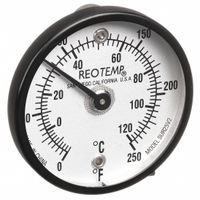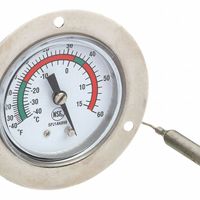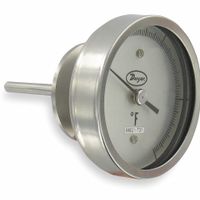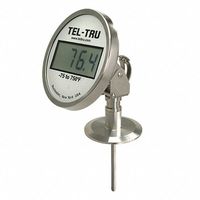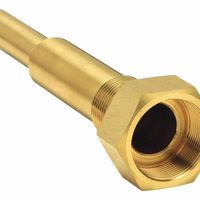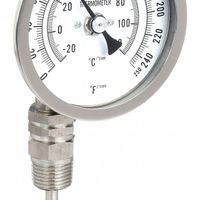Call +(254) 703 030 000 / 751 483 999 / 721 704 777
- Home
- Test Instruments
- Temperature And Environmental Measurement
- Fixed Location Thermometers Thermowells
.....Read More
Frequently Asked Questions
What are fixed-location thermometers used for?
Fixed-location thermometers are used for continuous monitoring and recording of temperature in a specific area or environment. They are essential in various fields for maintaining optimal conditions and ensuring safety, quality, and compliance with regulations.
In industrial settings, fixed-location thermometers monitor machinery and equipment temperatures to prevent overheating and ensure efficient operation. In the food industry, they help maintain proper storage temperatures to prevent spoilage and ensure food safety. In healthcare, they are used in hospitals and laboratories to monitor the temperature of sensitive medical supplies, vaccines, and biological samples, ensuring they remain within safe temperature ranges.
In meteorology, fixed-location thermometers are part of weather stations, providing data for climate studies and weather forecasting. In building management, they are used in HVAC systems to maintain comfortable indoor temperatures and optimize energy use. In agriculture, they help monitor environmental conditions in greenhouses and storage facilities, ensuring optimal growth conditions and preservation of produce.
Overall, fixed-location thermometers are crucial for maintaining controlled environments, ensuring product quality, safety, and compliance across various industries.
How do thread-mounted dial and digital thermometers work?
Thread-mounted dial and digital thermometers are used to measure temperature in various applications, such as in industrial processes, HVAC systems, and cooking.
**Dial Thermometers:**
These thermometers consist of a metal probe connected to a dial face. The probe contains a bimetallic strip or a gas-filled bulb. In bimetallic strip models, two metals with different expansion rates are bonded together. As temperature changes, the strip bends, moving a needle on the dial to indicate the temperature. In gas-filled models, the gas expands or contracts with temperature changes, moving a needle via a mechanical linkage. The thread mount allows the thermometer to be securely attached to a surface or a pipe, ensuring accurate readings.
**Digital Thermometers:**
Digital thermometers use electronic sensors, such as thermistors or thermocouples, to measure temperature. A thermistor changes its resistance with temperature, while a thermocouple generates a voltage proportional to temperature differences between two junctions. The sensor is housed in a probe, which is inserted into the medium being measured. The digital display shows the temperature reading, often with higher precision than dial thermometers. Thread mounts ensure stable positioning and consistent contact with the measured surface, enhancing accuracy.
Both types of thermometers are designed for easy installation and reliable performance. The choice between dial and digital depends on factors like required precision, ease of reading, and specific application needs.
What is the purpose of thermowells in thermometer installations?
Thermowells serve as protective barriers for temperature sensors, such as thermocouples, RTDs, or bimetallic thermometers, when installed in industrial processes. Their primary purpose is to shield these sensors from harsh process conditions, including high pressure, corrosive substances, and fluid flow, thereby extending the lifespan and ensuring the accuracy of the temperature measurement.
Constructed from robust materials like stainless steel, Inconel, or Hastelloy, thermowells are designed to withstand extreme environments. They are inserted into the process stream, allowing the temperature sensor to be installed inside the well without direct exposure to the process medium. This setup facilitates easy removal and replacement of the sensor for maintenance or calibration without interrupting the process.
Thermowells also help in minimizing the effects of fluid flow on the sensor, which can cause measurement errors due to vibration or thermal shock. By providing a stable environment, they ensure more reliable and consistent temperature readings.
Additionally, thermowells standardize the installation process, allowing for the use of different types of sensors without modifying the process equipment. This flexibility is crucial in industries where process conditions may change, requiring different sensor types or specifications.
In summary, thermowells protect temperature sensors from physical damage, chemical corrosion, and flow-induced forces, ensuring accurate and reliable temperature measurements while facilitating maintenance and sensor interchangeability.
How do remote reading panel-mount thermometers differ from fixed-location thermometers?
Remote reading panel-mount thermometers and fixed-location thermometers differ primarily in their design, functionality, and application.
Remote reading panel-mount thermometers are designed to provide temperature readings from a distance. They consist of a sensor or probe that is placed at the measurement site and a display unit that is mounted on a panel, often at a more convenient or accessible location. The sensor and display are connected via a cable or wireless technology, allowing the user to monitor temperature without being physically present at the measurement site. This setup is particularly useful in industrial settings, where the measurement site may be hazardous, difficult to access, or located in a different area from where the data is needed. These thermometers often feature digital displays and can include additional functionalities such as alarms, data logging, and integration with control systems.
Fixed-location thermometers, on the other hand, are installed directly at the site where the temperature is to be measured. They provide a direct reading at the point of installation and are typically used in applications where the temperature needs to be monitored locally. These thermometers can be analog or digital and are often simpler in design compared to remote reading thermometers. They are suitable for environments where the user can easily access the measurement site and where remote monitoring is not necessary.
In summary, the key differences lie in the ability of remote reading panel-mount thermometers to provide distant monitoring and enhanced functionality, while fixed-location thermometers offer straightforward, on-site temperature measurement.
What industries commonly use sanitary-clamp thermometers?
Sanitary-clamp thermometers are commonly used in industries where hygiene and precision are critical. These industries include:
1. **Food and Beverage Industry**: This sector requires strict hygiene standards to ensure food safety and quality. Sanitary-clamp thermometers are used in processes like pasteurization, fermentation, and cooking to monitor and control temperatures, ensuring that products are safe for consumption and meet regulatory standards.
2. **Dairy Industry**: In dairy processing, maintaining the correct temperature is crucial for pasteurization and fermentation. Sanitary-clamp thermometers help in monitoring these processes to ensure the safety and quality of milk, cheese, yogurt, and other dairy products.
3. **Pharmaceutical Industry**: This industry demands precise temperature control to ensure the efficacy and safety of drugs. Sanitary-clamp thermometers are used in the production of pharmaceuticals to monitor temperatures during mixing, fermentation, and storage processes, ensuring compliance with Good Manufacturing Practices (GMP).
4. **Biotechnology Industry**: In biotechnology, maintaining sterile conditions is essential. Sanitary-clamp thermometers are used in bioreactors and other equipment to monitor and control temperatures during the cultivation of microorganisms, ensuring optimal growth conditions and product consistency.
5. **Brewing Industry**: Temperature control is vital in brewing to ensure the quality and flavor of beer. Sanitary-clamp thermometers are used to monitor temperatures during mashing, fermentation, and storage, helping brewers maintain consistency and quality.
6. **Cosmetics Industry**: In the production of cosmetics, temperature control is important to ensure product stability and quality. Sanitary-clamp thermometers are used to monitor temperatures during mixing and filling processes, ensuring that products meet safety and quality standards.
These industries rely on sanitary-clamp thermometers for their ability to provide accurate temperature readings while maintaining hygienic conditions, essential for product safety and quality.
How do magnetic-back surface temperature thermometers attach to surfaces?
Magnetic-back surface temperature thermometers attach to surfaces using a magnet embedded in the back of the thermometer. This magnet is typically made from materials like neodymium, which are known for their strong magnetic properties. The magnet allows the thermometer to adhere securely to ferromagnetic surfaces, such as iron or steel, without the need for additional adhesives or fasteners.
When the thermometer is placed on a metal surface, the magnetic field generated by the magnet interacts with the metal, creating a force that holds the thermometer in place. This magnetic attraction is strong enough to keep the thermometer stable, even in environments where there might be vibrations or slight movements.
The design of these thermometers often includes a flat or slightly curved back to maximize contact with the surface, ensuring accurate temperature readings. The thermometer's sensor, usually located at the base, measures the temperature of the surface it is attached to. This direct contact allows for precise monitoring of surface temperatures, which is crucial in various industrial and laboratory settings.
Magnetic-back thermometers are particularly useful in situations where quick and temporary temperature measurements are needed, as they can be easily attached and removed without leaving any residue or damage. They are commonly used in HVAC systems, manufacturing processes, and other applications where monitoring the temperature of metal surfaces is essential.
What is the function of pipe-mounted surface temperature thermometers?
Pipe-mounted surface temperature thermometers are used to measure the temperature of the surface of pipes in various industrial and commercial applications. These thermometers provide critical data for monitoring and controlling processes that involve the transfer of fluids or gases through piping systems. By accurately measuring the surface temperature, they help ensure that the fluid inside the pipe is at the desired temperature, which is essential for maintaining process efficiency, safety, and product quality.
The primary function of these thermometers is to provide real-time temperature readings that can be used to adjust heating or cooling systems, ensuring that the fluid remains within specified temperature ranges. This is particularly important in industries such as chemical processing, oil and gas, HVAC, and food and beverage, where precise temperature control is crucial.
Additionally, pipe-mounted surface temperature thermometers can help detect potential issues such as heat loss, insulation failure, or blockages within the piping system. By identifying these problems early, maintenance can be performed proactively, reducing the risk of system failures and costly downtime.
These thermometers are typically designed to be easily mounted on the exterior of pipes without the need for intrusive installation, making them a convenient and non-invasive option for temperature monitoring. They often feature durable materials and construction to withstand harsh industrial environments and provide reliable performance over time.
In summary, pipe-mounted surface temperature thermometers play a vital role in process control, safety, and maintenance by providing accurate and timely temperature data for piping systems.
